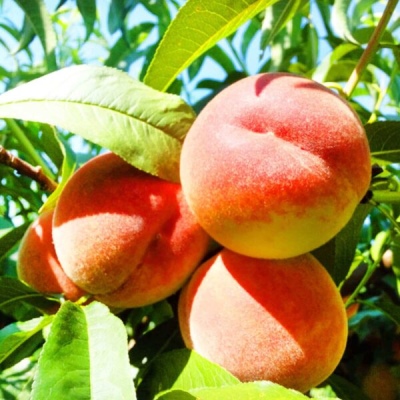
- Authors: Canada
- Name synonyms: Top Sweet T5
- Growth type: medium-sized
- Ripening period: late
- Appointment: for fresh consumption, for canning, for making juices
- Yield: high
- Marketability: high
- Transportability: high (5-6 days)
- Early maturity: begins bearing fruit for 3-4 years
- Growing regions: suitable for growing in various areas
Peach Top Sweet can be an excellent assistant for gardeners and delight them. But only the right methods of growing crops will provide a good result in due time. For gardeners, it is also necessary to know the basic botanical features of the plant.
Description of the variety
The plant of Canadian origin has an official synonym - Top Sweet T5. This medium-sized peach has excellent spreading.
Fruit characteristics
Especially large peaches Top Sweet T5 have a yellow-orange color. They are also characterized by a rich blush. In the official description, a rounded geometry is noted. The spread of mass can be from 190 to 280 g. And it is also worth paying attention to:
complete absence of pubescence;
rich orange color of the pulp;
decent separation of the bone from the soft part of the fruit.
Taste qualities
The harvested crop can be used fresh. And also it is used for canning and for obtaining juices. The expressive sweetness of the taste is noted. The tasting examination gave the Top Sweet T5 harvest an assessment of 5 points. It is worth paying attention, however, to a slight sour note.
Ripening and fruiting
The first peaches may appear in 3-4 years, not earlier. The variety is rather late in terms of development. Harvesting is usually done in the last decade of August. Of course, the weather can significantly affect these times. In some cases, collection is made in the first 10 days of September.
Yield
The Top Sweet T5 variety achieves decent productivity. The harvest of this peach has excellent marketability. The plant has a high commercial value. It can be used in both industrial and private gardens. The collected fruits are stored for 5-7 days outside the refrigerator.
Growing regions
The variety is declared suitable for cultivation in all possible climatic zones. In the main areas where peaches are grown, you can plant it in peace.
Growing and care
Pruning should be done annually. When pruning after planting, the branches are shortened to 40-45 cm.Every year, you should get rid of dry, damaged shoots. It is necessary to thin out and normalize the crown. Young plants need to be watered regularly.
The soil must be moistened so that the water reaches the roots. This is approximately to a depth of 40-45 cm. In the first 30 days of development, irrigation is carried out 1 time in 3 days, using 10 liters of water. In dry periods, you will need to use 15-20 liters each time.
Loosening of the land is required to be carried out systematically. Moreover, it is carried out shallowly. Weed grasses from the trunk circle are supposed to be removed as actively and diligently as possible. If you do not prune the peach when planting, or do not take care of regular watering, the effectiveness of plant engraftment will significantly decrease.
The soil is best loamy or some other area with low acidity. We must not forget about the danger of drafts. Shelters from them are provided with fences and other obstacles. Planting is calculated so that rooting occurs without exposure to cold. The landing pit is formed to your liking, but so that the landing would take place without problems.



Frost resistance and the need for shelter
The tree can withstand cold temperatures down to -32 degrees. Under such conditions, it is able to develop without additional shelter. Therefore, you can apply such a culture in the middle lane quite calmly.
Disease and pest resistance
Resistance to pathologies and harmful insects is relatively high. Especially high resistance to damage by curliness and powdery mildew. The protective measures against hazards are the same as for other fruit trees.

Requirements for soil and climatic conditions
A characteristic feature of Top Sweet T5 is attractive winter hardiness. The soil should vary depending on the rootstock used.
































































